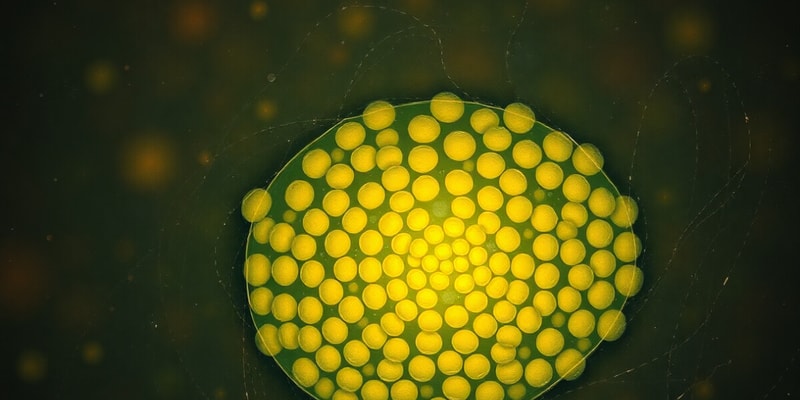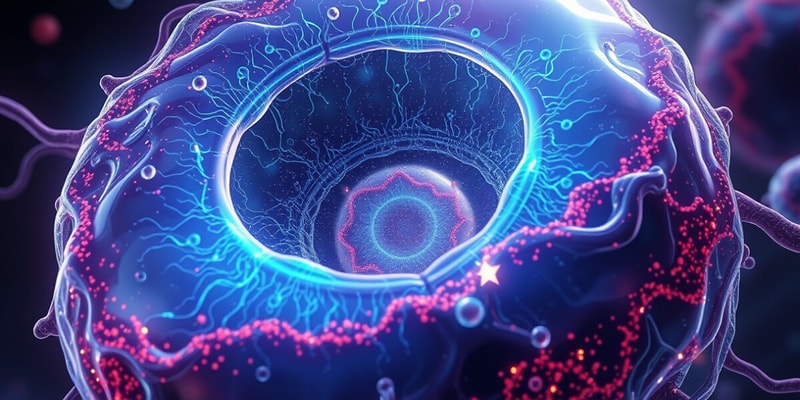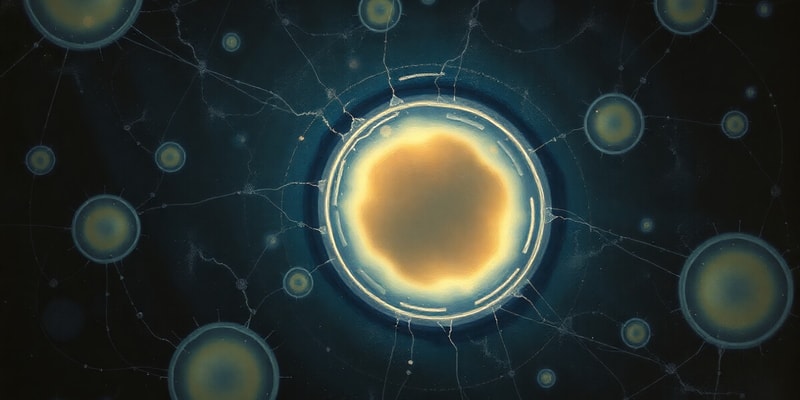Podcast Beta
Questions and Answers
Which statement about the lipid bilayer's fluidity is correct?
What role do glycolipids play in epithelial cells?
During apoptosis, what occurs to phosphatidylserine?
Which statement correctly describes the asymmetry of the lipid bilayer?
Signup and view all the answers
Which factor contributes to the decrease in fluidity of the lipid bilayer at higher temperatures?
Signup and view all the answers
What is the composition of gangliosides?
Signup and view all the answers
What is one function of peripheral membrane proteins?
Signup and view all the answers
Ganglioside GM1 serves which significant role?
Signup and view all the answers
What facilitates the movement of phospholipids across the lipid bilayer?
Signup and view all the answers
What happens to the lipid bilayer at its freezing point?
Signup and view all the answers
What role does the plasma membrane play in cellular functions?
Signup and view all the answers
How do double bonds in fatty acid tails affect the fluidity of the membrane?
Signup and view all the answers
What is the main structural characteristic of phospholipids?
Signup and view all the answers
What is a defining feature of lipid rafts in the plasma membrane?
Signup and view all the answers
Which of the following statements about membrane asymmetry is true?
Signup and view all the answers
What type of molecules are included in the category of sterols?
Signup and view all the answers
Which phospholipid is the only one with a net negative charge at physiological pH?
Signup and view all the answers
What is the primary function of the plasma membrane's barrier property?
Signup and view all the answers
What are the primary components of a glycerophospholipid?
Signup and view all the answers
How do hydrophobic molecules behave in the presence of water?
Signup and view all the answers
What is the primary role of cholesterol in the plasma membrane?
Signup and view all the answers
Which component of a phospholipid contributes to its amphipathic nature?
Signup and view all the answers
Which of the following statements best describes the fluid mosaic model?
Signup and view all the answers
How does the presence of double bonds in fatty acid tails affect membrane fluidity?
Signup and view all the answers
What defines the asymmetry observed in the plasma membrane?
Signup and view all the answers
Which type of lipid is most abundant in the plasma membrane?
Signup and view all the answers
What is a key function of lipid rafts in the plasma membrane?
Signup and view all the answers
What characterizes the hydrophobic molecules in relation to water?
Signup and view all the answers
What type of phospholipid is also known as phosphoglycerides?
Signup and view all the answers
Which of the following molecules is NOT a component of the lipid bilayer?
Signup and view all the answers
What impact does cholesterol have on membrane fluidity at different temperatures?
Signup and view all the answers
What is the role of phosphatidylserine during apoptosis?
Signup and view all the answers
Which of the following statements about glycolipids is TRUE?
Signup and view all the answers
What differentiates sphingomyelin from other phospholipids in the lipid bilayer?
Signup and view all the answers
Which statement best describes the lateral movement of lipids within the lipid bilayer?
Signup and view all the answers
What role does ganglioside GM1 have in relation to cholera?
Signup and view all the answers
Which phospholipid is found primarily in the inner leaflet of the plasma membrane?
Signup and view all the answers
How does membrane asymmetry arise in the lipid bilayer?
Signup and view all the answers
What is a primary function of peripheral membrane proteins?
Signup and view all the answers
What leads to an increase in fluidity of a lipid bilayer?
Signup and view all the answers
How do lipid rafts influence membrane organization?
Signup and view all the answers
What effect do longer fatty acid tails have on membrane fluidity?
Signup and view all the answers
Which component of phospholipids contributes to their amphipathic nature?
Signup and view all the answers
What is the primary function of the plasma membrane's selective permeability?
Signup and view all the answers
How do phospholipids aggregate in water?
Signup and view all the answers
Which type of lipids are primarily responsible for membrane structure and fluidity?
Signup and view all the answers
What is a key characteristic of hydrophilic molecules in relation to water?
Signup and view all the answers
Which structure is most likely to decrease membrane fluidity?
Signup and view all the answers
What is one of the main functions of the plasma membrane in a cell?
Signup and view all the answers
What happens to hydrophobic molecules in an aqueous environment?
Signup and view all the answers
What is the role of cholesterol in the lipid bilayer at higher temperatures?
Signup and view all the answers
Which statement explains the movement of phospholipid molecules within the lipid bilayer?
Signup and view all the answers
What characterizes the behavior of glycolipids in the plasma membrane?
Signup and view all the answers
Which glycolipid is specifically known to serve as a receptor for cholera toxin?
Signup and view all the answers
During apoptosis, what significant change occurs to phosphatidylserine?
Signup and view all the answers
What structural feature is common to gangliosides?
Signup and view all the answers
What leads to membrane asymmetry in the lipid bilayer?
Signup and view all the answers
Which of the following statements about the fluidity of the lipid bilayer is true?
Signup and view all the answers
What is the role of phosphatidylcholine and sphingomyelin in the lipid bilayer?
Signup and view all the answers
What is a significant role of peripheral membrane proteins?
Signup and view all the answers
Study Notes
Plasma Membrane Functions
- Serves as a barrier for the cell, protecting it from the external environment.
- Acts as a selectively permeable "filter," controlling the movement of various molecules across the membrane.
- Responds to environmental signals through receptors and channels.
- Provides attachment points for the cytoskeleton, maintaining cell shape and structure.
- Facilitates interactions between cells (cell-cell) and between cells and the extracellular matrix (ECM).
The Fluid Mosaic Model
- Describes the plasma membrane as a dynamic and fluid structure composed of a mixture of lipids, proteins, and carbohydrates.
- Features two leaflets: the outer leaflet facing the extracellular space and the inner (cytosolic) leaflet facing the cytoplasm.
Hydrophobic vs. Hydrophilic
- Hydrophobic molecules are water-insoluble and tend to cluster together in aqueous environments, reducing free energy.
- Hydrophilic molecules are water-soluble, containing polar groups that form electrostatic and hydrogen bonds with water molecules.
Membrane Lipids
-
Phospholipids: Amphipathic molecules with hydrophilic heads and hydrophobic tails.
-
Glycerophospholipids:
- Composed of a glycerol backbone, two fatty acids, a phosphate group, and an alcohol headgroup.
-
Sphingolipids:
- Composed of a sphingosine backbone, one fatty acid, a phosphate group, and a choline headgroup.
-
Glycerophospholipids:
- Glycolipids: Sphingolipids with a mono- or oligosaccharide (sugar) headgroup.
- Sterols: Include cholesterol and other sterol-based lipids, essential for membrane structure and fluidity.
Phospholipids
- Most abundant membrane lipids.
- Consist of a hydrophilic head and two hydrophobic tails, which are fatty acids containing 14-24 carbon atoms.
- One tail often contains cis-double bonds, making it unsaturated.
- Double bonds create kinks in the tail, increasing membrane fluidity. Longer tails decrease fluidity.
The Four Major Phospholipids
- Phosphatidylcholine, phosphatidylethanolamine, phosphatidylserine, and sphingomyelin.
- Only phosphatidylserine has a net negative charge at physiological pH.
Glycerol-Based Phospholipids: Phosphoglycerides
- Glycerol-based phospholipids, also known as phosphoglycerides, are a major class within the phospholipid family.
The Lipid Bilayer Is a Two-Dimensional Fluid
- Lipid molecules move laterally within a monolayer.
- Lipids rotate about their long axis.
- Tails swing from side to side and contract.
- Phospholipids rarely migrate across the bilayer but can be transported by flippases or phospholipid translocators.
- Phosphatidylserine is typically in the inner leaflet but is redistributed to the outer leaflet during apoptosis.
Cell Membrane Fluidity and Its Factors
- Lipid bilayers transition from a liquid state to a gel state at a freezing point (phase transition).
- Factors influencing membrane fluidity:
- Short hydrocarbon chains with double bonds promote fluidity.
- Cholesterol plays a role in regulating fluidity:
- At higher temperatures, cholesterol reduces fluidity.
- At lower temperatures, cholesterol prevents rigidity.
Glycolipids
- Sugar-containing lipids present on the outer leaflet of the membrane.
- Self-associate via hydrogen bonds between sugars and van der Waals forces between hydrocarbon chains.
- Play a protective role, particularly in epithelial cells where they protect against low pH and enzymes.
- Involved in cell recognition; for example, ganglioside GM1 serves as a receptor for cholera toxin.
Gangliosides Are Glycolipids
- Glycolipids composed of the sphingolipid ceramide and an oligosaccharide with one or more sialic acid residues.
- Highly enriched in neurons, primarily located in the outer leaflet of the plasma membrane.
- Participate in cell-cell recognition, adhesion, and signaling.
- Autoimmune responses against gangliosides can lead to conditions like Guillain-Barré syndrome.
- Sialic acid residues on gangliosides serve as receptors for influenza A viruses.
Asymmetry of the Lipid Bilayer
- The two leaflets of the membrane have different lipid compositions.
- Outer leaflet: phosphatidylcholine, sphingomyelin, and glycoproteins with carbohydrates facing the extracellular space.
- Inner leaflet: phosphatidylserine, phosphatidylethanolamine, phosphatidylinositol, and peripheral membrane proteins facing the cytoplasm.
- Cytosolic proteins may bind specific lipid heads, further contributing to asymmetry.
- Phosphatidylserine translocates to the outer leaflet during apoptosis, signaling macrophages to phagocytose the dying cell.
- Asymmetry is established through transporters and spontaneous flip-flop movements.
Plasma Membrane Functions
- Barrier: Protects the cell from its environment.
- Selectively Permeable: Allows for the transport of specific molecules in and out of the cell.
- Responds to Environment: Detects changes in the environment through receptors and channels.
- Attachment Point: Connects to the cytoskeleton for structural support.
- Cell Interactions: Facilitates communication between cells and the extracellular matrix (ECM).
Fluid Mosaic Model
- The plasma membrane is a flexible structure composed of lipids, proteins, and carbohydrates.
- It has two layers (leaflets): an outer leaflet facing the extracellular space and an inner leaflet facing the cytoplasm.
Hydrophobic vs. Hydrophilic
- Hydrophobic: Water-insoluble molecules that cluster together in water to minimize the energy cost of interaction with water.
- Hydrophilic: Water-soluble molecules with polar groups that form bonds with water.
Membrane Lipids
-
Phospholipids:
-
Glycerophospholipids:
- Backbone: Glycerol
- Components: 2 fatty acids, phosphate group, alcohol headgroup
-
Sphingolipids:
- Backbone: Sphingosine
- Components: 1 fatty acid, phosphate group, choline headgroup
-
Glycerophospholipids:
-
Glycolipids:
-
Sphingolipids:
- Backbone: Sphingosine
- Components: 1 fatty acid, mono- or oligosaccharide sugar headgroup
-
Sphingolipids:
-
Sterols:
- Includes cholesterol and other sterol-based lipids
- Important for membrane structure and fluidity
Phospholipids
- Amphipathic: Have a hydrophilic head and a hydrophobic tail.
- Abundant in Membranes: Phospholipids are the most common membrane lipids, typically with one head and two tails.
-
Fatty Acid Tails:
- Contain 14-24 carbon atoms
- One tail usually has one or more cis-double bonds, making it unsaturated.
- Double bonds introduce kinks in the tails, increasing membrane fluidity.
- Longer tails decrease membrane fluidity.
The Four Major Phospholipids
- Phosphatidylcholine: Electrically neutral at physiological pH.
- Phosphatidylethanolamine: Electrically neutral at physiological pH.
- Phosphatidylserine: Has a net negative charge at physiological pH.
- Sphingomyelin: Electrically neutral at physiological pH.
Glycerol-Based Phospholipids: Phosphoglycerides
- Phosphoglycerides are a type of phospholipid that is based on glycerol.
Lipid Bilayer Fluidity
- Lateral Movement: Lipid molecules move freely within the same layer of the bilayer.
- Rotation: Lipids rotate around their long axis.
- Flexing: Tail sections can swing and contract.
- Translocation: Phospholipids rarely cross the bilayer, but this can be facilitated by flippases or phospholipid translocators.
- Apoptosis: During cell death, phosphatidylserine is redistributed to the outer leaflet as a signal for phagocytosis by macrophages.
Factors Affecting Membrane Fluidity
- Phase Transition: The change from a liquid state to a gel state at a specific temperature.
- Hydrocarbon Chain Length: Shorter chains result in greater fluidity.
- Double Bonds: More double bonds lead to more fluidity due to kinks in the tails.
-
Cholesterol:
- High Temperatures: Cholesterol reduces fluidity.
- Low Temperatures: Cholesterol reduces rigidity.
Glycolipids
- Location: Found on the outer leaflet of the bilayer.
- Composition: Contain sugars.
- Self-Association: Glycolipids associate through hydrogen bonding between sugars and van der Waals forces between hydrocarbon tails.
- Protection: Glycolipids on the apical surface of epithelial cells protect against low pH and enzymes.
- Cell Recognition: Examples include ganglioside GM1, a cholera toxin receptor.
Gangliosides
- Composition: Sphingolipid ceramide with an oligosaccharide containing one or more sialic acid residues.
- Location: Abundant in neurons, especially on the outer leaflet of the plasma membrane.
- Function: Involved in cell recognition, adhesion, and signaling.
- Guillain-Barré Syndrome: Autoimmune response to cell surface gangliosides causing nerve damage.
- Influenza A Viruses: Use sialic acid residues as receptors to enter cells.
Asymmetry of the Lipid Bilayer
-
Distribution:
- Outer leaflet: phosphatidylcholine, sphingomyelin
- Inner leaflet: phosphatidylserine, phosphatidylethanolamine, phosphatidylinositol
-
Proteins:
- Outer leaflet: glycoproteins with carbohydrates facing the extracellular space
- Inner leaflet: peripheral membrane proteins facing the cytoplasm
- Cytosolic proteins binding to specific lipid heads
-
Apoptosis: During cell death, phosphatidylserine translocates to the outer leaflet, signaling macrophages to engulf the dead cell.
-
Mechanisms: Asymmetry is maintained by transporters and spontaneous flip-flop movements.
Plasma Membrane Functions
- Protects the cell
- Selectively permeable: Transports molecules in and out of the cell
- Responds to the environment using receptors and channels
- Attaches to the cytoskeleton
- Facilitates cell-cell and cell-extracellular matrix interactions
The Fluid Mosaic Model
- The plasma membrane is composed of lipids, proteins, and carbohydrates
- Composed of two layers (leaflets): Outer leaflet and inner leaflet (cytosolic)
Hydrophobic vs. Hydrophilic Molecules
- Hydrophobic: Water-insoluble; water molecules form "cages" around them
- Hydrophilic: Water-soluble; polar groups form electrostatic and hydrogen bonds with water
Membrane Lipids: Phospholipids
- Phospholipids are the most abundant membrane lipids
- Consists of a hydrophilic head and hydrophobic tails
- Tails are fatty acids with a length of 14-24 carbon atoms
- Unsaturated tails: Have cis-double bonds and are more fluid
- Saturated tails: Lack double bonds and are less fluid
Glycerol-Based Phospholipids: Phosphoglycerides
- Phosphoglycerides: Composed of glycerol, two fatty acids, a phosphate group, and an alcohol head group
- Phosphatidylserine: Has a net negative charge at physiological pH
Sphingolipids
- Backbone: Sphingosine
- Components: One fatty acid, a phosphate group, and choline (headgroup)
Glycolipids
- Backbone: Sphingosine
- Components: One fatty acid and a mono- or oligosaccharide (sugar headgroup)
- Found on the outer leaflet of the plasma membrane
- Protective role: In epithelial cells, glycolipids are on the apical surface, protecting against low pH and enzymes.
- Cell recognition role: Ganglioside GM1 is a receptor for the bacterial toxin causing the diarrhea of cholera
Gangliosides
- Glycolipids: Made of the sphingolipid ceramide and an oligosaccharide with one or more sialic acid residues
- Abundant in neurons, found primarily in the outer leaflet of the plasma membrane
- Involved in cell-cell recognition, adhesion, and signaling
- Guillain-Barré Syndrome: Autoimmune response to cell surface gangliosides
- Influenza A Viruses: Recognize sialic acid residues on cell surfaces as receptors
Sterols
- Including cholesterol, sterol-based lipids are important for membrane structure and fluidity
The Lipid Bilayer: A Two-Dimensional Fluid
- Lipid molecules move laterally within a monolayer
- Lipids rotate about their long axis
- Tails swing from side to side and contract
- Flippase: Facilitates phospholipid migration across the bilayer
- Phosphatidylserine: Usually in the inner leaflet but redistributed to the outer leaflet during apoptosis
Cell Membrane Fluidity
- Phase Transition: Lipid bilayers change from a liquid state to a gel state at a freezing point (phase transition)
-
Fluidity Factors:
- Short hydrocarbon chains increase fluidity.
- Double bonds in the hydrocarbon chains increase fluidity.
- Cholesterol decreases fluidity at higher temperatures and increases fluidity at lower temperatures.
Asymmetry of the Lipid Bilayer
- Outer leaflet: Phosphatidylcholine, sphingomyelin, glycoproteins, and carbohydrates
- Inner leaflet: Phosphatidylserine, phosphatidylethanolamine, phosphatidylinositol, peripheral membrane proteins, and cytosolic proteins
- During apoptosis, phosphatidylserine moves to the outer leaflet and signals to the macrophages to phagocytose the dead cell.
- Asymmetry is created through transporters and spontaneous flip-flop movements.
Studying That Suits You
Use AI to generate personalized quizzes and flashcards to suit your learning preferences.
Related Documents
Description
This quiz explores the essential functions of the plasma membrane, including its role as a selective barrier and its dynamic structure as described by the fluid mosaic model. Additionally, it discusses the properties of hydrophobic and hydrophilic molecules and their significance in cell interactions. Test your understanding of these fundamental concepts in cell biology.




